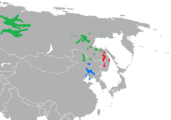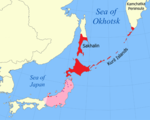Altaic languages
The concept of Altaic languages refers to a language macrofamily proposal that is widely questioned today, which would group several families of languages spoken mainly in Central Asia, especially Turkic and Mongolian. The existence of the Altaic family is debated among historical linguists, as it has been almost universally rejected. The name comes from the Altai massif, a mountain range in Central Asia.
Proponents of the Altaic languages include the following families:
- Turkic languages
- Mongolic languages
- Tungu languages
Often include the Japanese and Korean language groups as well. The inclusion of Ainu has also been suggested. But the inclusion of these three groups is even more insecure and is rejected by many specialists.
The Altaic languages have recently been considered as a Sprachbund.
History of Altaic theory
The Altaic family, under the name of "Tatar", was postulated in 1849 by Schott as a group of languages that united Turkic, Mongolian and Tungus. Previously the idea that these three language groups are related was conjectured by Philip Johan von Strahlenberg (1730) who was a Swedish officer who traveled the eastern region of the Russian Empire as a prisoner of war during the Great Northern War. Schott used the name "Altaic" for what more recently was called the Uralo-Altaic family, a phylogenetic grouping rejected today by most linguists. Castrés proposed similar theories in 1862, but classified Turkic with what he called Uralic. In the middle of the XX century, Nicholas Poppe (1960) carried out an enormous amount of comparative work, based on which he proposed a hypothetical reconstruction of the system phonological proto-Altaic and a few hundred cognates.
Anton Boller proposed in 1857 to add Korean and Japanese. In 1920 G. J. Ramstedt and Yevgeni Polivanov proposed further etymologies for Korean. The Japonic language group is usually related to Korean (eg Samuel Martin 1966) and in 1971 Roy Miller proposed to relate Japanese to Korean and the Altaic languages. The proposal has been taken up and developed by various other linguists such as Sergei Starostin.
Ainu has sometimes been related to the Altaic group, for example by Street (1962) and Patrie (1982). However, the latest research relates it to the Austroasiatic languages.
Oponents of the theory claim that it is based primarily on typological similarities such as vowel harmony, lack of grammatical gender, and being agglutinative. In fact, a series of etymologies have been proposed (Ramstedt, Martin, Stárostin), but they are rejected as a result of intense borrowing or mutual influences due to long contacts between the peoples. Thus linguists such as Doerfer 1963 or Bernard Comrie 1981 do not consider the Altaic languages as a valid family, but as three (or more) separate families of languages.
Common features
Many of the similarities found between the Altaic languages could be typological in origin, rather than inherited from a common ancestor. Among these traits widespread among the Altaic languages would be:
- The preferred basic order SOV.
- The existence of postpositions instead of prepositions.
- Having a strongly agglutant character achieved by the aglutination of a large number of suffixes.
- Absence of nominal or grammatical classes.
In addition, many Altaic languages possess vowel synharmony, a feature that could be due to phonological sprachbund type linguistic contact.
Phonology
The work of Poppe [1960], Starostin [2003], Blažek [2006] and others has led to a hypothetically reconstructed phonological system for the ancestor of the Altaic languages whose consonant system is given by:
Bilabial Alveolar/dental Alveo-palatal Post-alveolar Palatal Velar Occlusive vacuum ♪ ♪ *kh sorda ♪ ♪ ♪ Sonora ♪ ♪ ♪ Africada vacuum *tgilh sorda *tgil Sonora ♪ Fridge sorda ♪ * Sonora ♪1 Nasal ♪ ♪ ♪ * Gothic ♪2 *rj Approximately ♪ ♪ ♪2
1 This phoneme only occurs at the beginning of a word.
2 This phoneme only appears in word interior position.
The vowel inventory is given by:
Previous Poster non-rounded rounded Closed ♪ ♪ ♪ Media ♪ ♪ ♪ Half-open ♪ Open ♪
It is not clear to what extent/æ/, /ø/, /y/ are monophthongs such as conjectured here (presumably [æ œ~ø ʏ~y]) or diphthongs ([i̯a~i̯ɑ i̯ɔ~i̯o i̯ʊ~i̯u]); the evidence is not unequivocal. In any case, these vowels appear only (sometimes only) on the first syllable. All the vowels can be long or short, being the opposition of phonemic quantity in the first syllable. Starostin et al. (2003) consider that vowel quantity, like pitch, is a supragmental feature in Altaic languages.
Macro-Altaic languages
The terms macro-Altaic and its synonym, trans-Eurasian, are used to group the Altaic languages, but also include the Japonic languages, and occasionally Ainu.; In such a way that in this context, the terms Altaic or Micro-Altaic would exclusively define the relationship between the Turkic, Mongolian and Tungusic languages. The Macro-Altaic group has been supported by the reconstruction of some 635 proto-words (lexical entries).
Lexical comparison
Although only a small number of cognates were recognized and there are many doubts about certain reconstructions, the following table is a typical sample of comparative work on Macro-Altaic languages:
GLOSA PROTO-
ALTAICOPROTO-TURQUICO Mongolic Tungúsico Japan Core PROTO-MONGOLICO PROTO-TUNGUS. PROTO-JAPAN Coreanicantiguous 'One' *bjuri *bīr *nig margin ♪ ♪ ♪ 'two' *puču * slowk(k)i *koyar ♪ durur ♪ bitch ♪ tupir 'three' ♪ *üč *gurban ♪ *urufu ♪ seki 'four.' ♪torj- *t *rt ♪ dörben *dügin ♪ *neki 'five' ♪ *b turning shed(k) *tabun ♪ ♪ ♪ 'six' ♪ *altı *jirguxambin ♪ ♪ *j variations 'siete' * *j pacet(t)i *dolux ♪ Nadan ♪ *nidkup 'Ocho' ♪ *seki *najman ♪ daapun ♪ ♪ and bulterp 'nine' *keg- ♪ ♪ Yesterdaysün *xüyägin *kono ♪ 'ten' *tjub- ♪ *xarban * d *uan *towo ♪
Relationships
On the other hand, other investigations suggest that Japonic would have a closer relationship with the Austronesian languages, however, it is possible that this rapprochement is due to contact between the Neolithic macro-Altaic Xinglongwa culture (Liao River, China) in contact with peoples who had a sister language to Proto-Austronesian during the expansion of millet and rice agriculture in the 6th millennium BC. The relationships would be as follows:
| Macro-altaico |
| ||||||||||||||||||||||||





